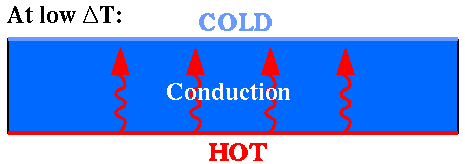Convection

Consider a thin layer of fluid which is heated from below and cooled
from above. At low temperature differences, the viscosity of the fluid
keeps the fluid from moving and the heat is conducted from the bottom
to the top.

However, there is an instability in the system due to the fact that the
water on the bottom is expanding due to the higher temperature and becoming
less dense, and hence experiencing an upward bouyancy force,
while the fluid on the top is cooler and denser and experiencing a
downward gravitational force.

There is some temperature difference above which this instability leads to a
steady flow of fluid, which rises and falls in small rolls. This temperature
depends on many physical characteristics of the system, such as fluid
viscosity and density, cell geometry, etc. This fluid motion is called
convection.
This convection is the same phenomenon which can be seen in a pot of water
on the stove. On the surface of the sun, however, there is a highly charged
plasma rather than water, and when convective flows begin, magnetic fields
form. These magnetic fields interact with the charged particles which in
turn change the magnetic fields. Regions where very high magnetic fields
form create sunspots.
previous | next
Eigenfunction Analysis of Coherent Structures on the Solar Surface
Authoring NASA Official:Dr. Milton Halem, Chief, Earth
and Space Data Computing Division
Contact:Marilyn Mack/Code 930
marilyn.j.mack.1@gsfc.nasa.gov



